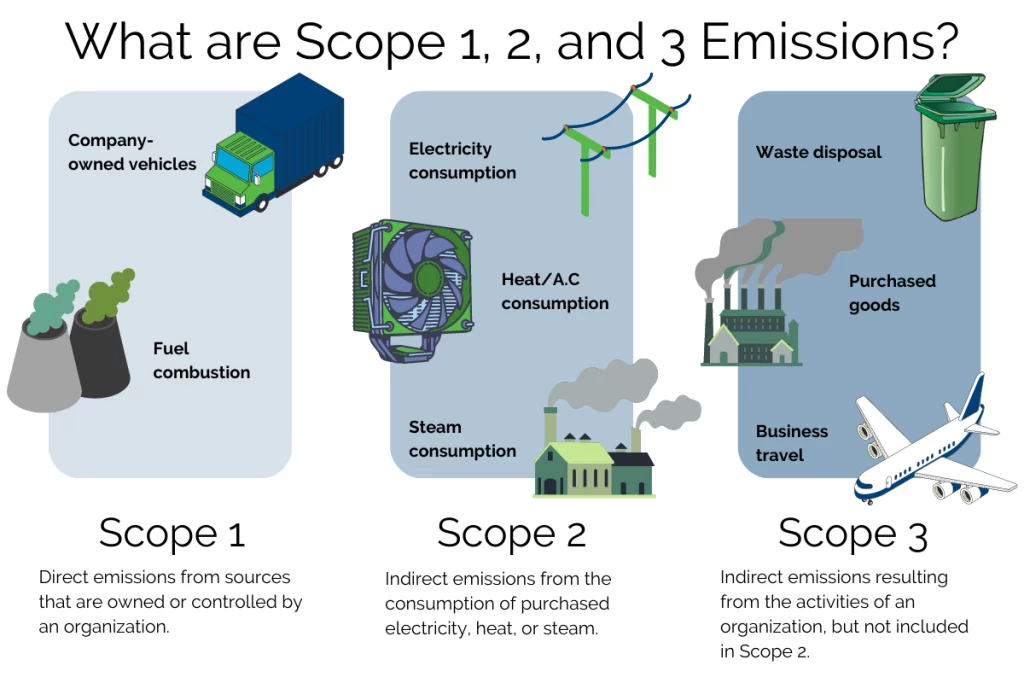Table of contents

Scope 1, 2, and 3 emissions are the three categories of greenhouse gas emissions that are commonly reported by businesses. These categories of carbon emissions, which were established by the World Resources Institute’s Greenhouse Gas Protocol (GHG Protocol), are used to help organizations track and manage their greenhouse gas emissions in a consistent and transparent manner.
Scope 1 Emissions
Scope 1 emissions are direct emissions from sources that are owned or controlled by an organization. Examples of scope 1 emissions could be emissions from on-site fossil fuel combustion, including process emissions and those from industrial processes, refrigeration, heating, air conditioning, electricity generation, and emissions from company-owned vehicles.
Scope 2 Emissions
Scope 2 emissions are indirect emissions from the consumption of purchased electricity, heat, or steam. These emissions are not directly controlled by the reporting entity. Rather, they are a result of its activities and can be influenced by purchasing decisions. For example, if a company purchases electricity from a power plant that generates electricity from coal, the emissions from the power plant are considered scope 2 emissions for the company.
Scope 3 Emissions
Scope 3 emissions are all other indirect emissions that are a result of the activities of an organization, but are not included in scope 2. Examples of scope 3 emissions include emissions from employee commuting and business travel, waste disposal, and the use of purchased goods and services throughout an organization’s supply chain/value chain.


Want to share this image on your site? Click here to copy and paste the code.
<p><strong>Please include attribution to certaintysoftware.com with this graphic.</strong><br /><br /><a href='https://www.certaintysoftware.com/what-are-scope-1-2-3-emissions/'><img src='https://www.certaintysoftware.com/wp-content/uploads/2023/01/Scope-123-Emissions-Infographic.webp' alt='What are scope 1, 2, and 3 emissions?' width='600px' /></a></p>
Why it’s Important to Understand These Differences
Understanding and managing scope 1, 2, and 3 GHG emissions are essential for businesses for several reasons. First, greenhouse gas emissions are a major contributor to climate change, which can have significant environmental and economic impacts. By reducing their emissions and carbon footprint, businesses can help mitigate the negative effects of climate change and support the transition to a low-carbon economy.

30+ Audit and inspection checklists free for download.
Second, managing scope emissions can help businesses improve their environmental performance. Also, it can contribute to sustainable development or net zero policies and goals, reduce energy consumption and meet regulatory requirements. Many governments have established targets and regulations to reduce greenhouse gas emissions. Businesses that are able to demonstrate progress in reducing their emissions may be eligible for incentives and other benefits.
Third, managing emissions can help businesses improve their reputation and gain a competitive advantage. Increasingly, consumers, stakeholders, and investors are looking for organizations that are committed to sustainability and reducing their environmental impact. By managing their emissions and reporting on their progress, businesses can demonstrate their commitment to sustainability and potentially attract more customers and investors.
How to Better Collect Information on Scope 1, 2, and 3 Emissions
The task of quantifying CO2 and other GHG emissions – GHG accounting – may seem like a daunting task – and for some large complex businesses this may be the case – but the process of doing so is straightforward. Emissions reporting is accomplished by first establishing the reporting standard to use (i.e. the GHG Protocol). Next, you’ll want to define the scope of your emissions inventory (i.e. describing the boundary of total emissions to be calculated through your product or service lifecycle, your supply chain, and any other value chain emissions to be included). Finally, quantify the total GHG emissions within that scope.
In addition, businesses can work with their suppliers to encourage the adoption of more sustainable practices and the reporting of GHG emissions data. This may involve providing support and resources to help suppliers understand the GHG Protocol and implement emissions reduction strategies. It may also involve working with industry associations and other organizations to develop and promote best practices for GHG emissions reporting and reduction.
Businesses should regularly audit and inspect the performance of suppliers using checklists such as a Supplier Social and Environmental Compliance Checklist. Consider using this checklist to internally perform the inspection, or send it to your suppliers to perform the inspection themself.
Overall, scope 1, 2, and 3 emissions are an important aspect of a business’s environmental performance. Understanding and managing these emissions can have significant benefits for businesses, the environment, and society as a whole.
You may also be interested in:



